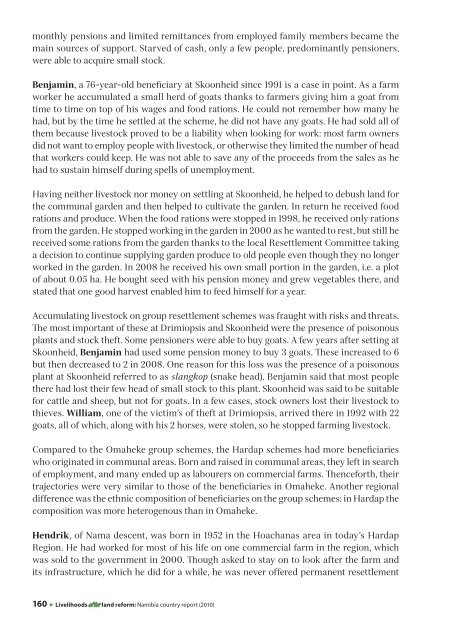Namibia country report
Namibia country report
Namibia country report
- No tags were found...
Create successful ePaper yourself
Turn your PDF publications into a flip-book with our unique Google optimized e-Paper software.
monthly pensions and limited remittances from employed family members became themain sources of support. Starved of cash, only a few people, predominantly pensioners,were able to acquire small stock.Benjamin, a 76-year-old beneficiary at Skoonheid since 1991 is a case in point. As a farmworker he accumulated a small herd of goats thanks to farmers giving him a goat fromtime to time on top of his wages and food rations. He could not remember how many hehad, but by the time he settled at the scheme, he did not have any goats. He had sold all ofthem because livestock proved to be a liability when looking for work: most farm ownersdid not want to employ people with livestock, or otherwise they limited the number of headthat workers could keep. He was not able to save any of the proceeds from the sales as hehad to sustain himself during spells of unemployment.Having neither livestock nor money on settling at Skoonheid, he helped to debush land forthe communal garden and then helped to cultivate the garden. In return he received foodrations and produce. When the food rations were stopped in 1998, he received only rationsfrom the garden. He stopped working in the garden in 2000 as he wanted to rest, but still hereceived some rations from the garden thanks to the local Resettlement Committee takinga decision to continue supplying garden produce to old people even though they no longerworked in the garden. In 2008 he received his own small portion in the garden, i.e. a plotof about 0.05 ha. He bought seed with his pension money and grew vegetables there, andstated that one good harvest enabled him to feed himself for a year.Accumulating livestock on group resettlement schemes was fraught with risks and threats.The most important of these at Drimiopsis and Skoonheid were the presence of poisonousplants and stock theft. Some pensioners were able to buy goats. A few years after setting atSkoonheid, Benjamin had used some pension money to buy 3 goats. These increased to 6but then decreased to 2 in 2008. One reason for this loss was the presence of a poisonousplant at Skoonheid referred to as slangkop (snake head). Benjamin said that most peoplethere had lost their few head of small stock to this plant. Skoonheid was said to be suitablefor cattle and sheep, but not for goats. In a few cases, stock owners lost their livestock tothieves. William, one of the victim’s of theft at Drimiopsis, arrived there in 1992 with 22goats, all of which, along with his 2 horses, were stolen, so he stopped farming livestock.Compared to the Omaheke group schemes, the Hardap schemes had more beneficiarieswho originated in communal areas. Born and raised in communal areas, they left in searchof employment, and many ended up as labourers on commercial farms. Thenceforth, theirtrajectories were very similar to those of the beneficiaries in Omaheke. Another regionaldifference was the ethnic composition of beneficiaries on the group schemes: in Hardap thecomposition was more heterogenous than in Omaheke.Hendrik, of Nama descent, was born in 1952 in the Hoachanas area in today’s HardapRegion. He had worked for most of his life on one commercial farm in the region, whichwas sold to the government in 2000. Though asked to stay on to look after the farm andits infrastructure, which he did for a while, he was never offered permanent resettlement160 ● Livelihoods after land reform: <strong>Namibia</strong> <strong>country</strong> <strong>report</strong> (2010)
















